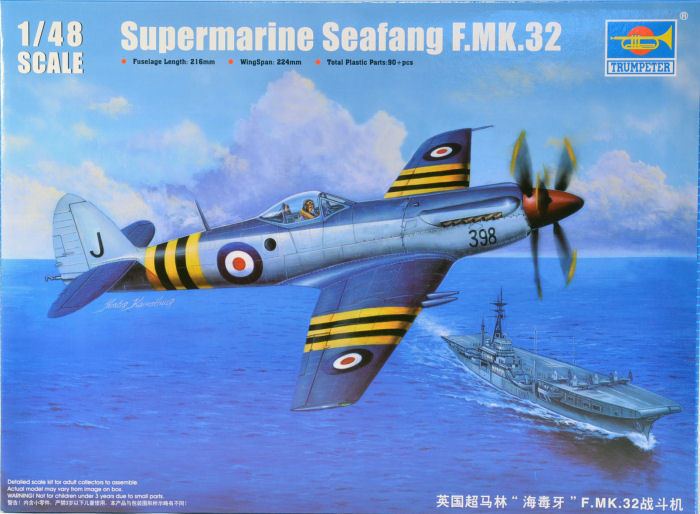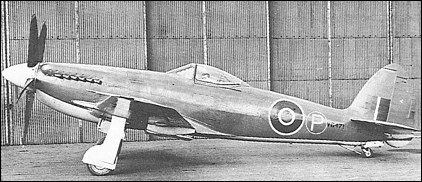Top speed 765 km/h Length 10 m | Wingspan 11 m First flight 1946 Designer Joseph Smith | |
 | ||
World of warplanes british multirole fighter supermarine seafang f 32
The Supermarine Seafang was a British Rolls-Royce Griffon–engined fighter aircraft designed by Supermarine to Air Ministry specification N.5/45. It was a further development of Supermarine's famous Spitfire and Spiteful aircraft, becoming "a Spitfire too far".
Contents
- World of warplanes british multirole fighter supermarine seafang f 32
- Il2 1946 supermarine seafang f mk32
- Design and development
- Drawing board design
- Variants
- Operators
- Specifications Seafang 32
- References
Il2 1946 supermarine seafang f mk32
Design and development

The Seafang was essentially a Spiteful redesigned for Royal Navy carrier use, with the addition of an arrester hook, a contra-rotating propeller to eliminate engine torque effects, and power folding outer wing panels.

Two prototype Type 396 Seafang Mark 32s were ordered on 12 March 1945 followed by an order for 150 Type 382 Seafang Mark 31s on 7 May 1945. To expedite entry into service the interim Mark 31 was ordered which was a navalised Spiteful, basically a Spiteful with an arrestor hook. This would allow the Mark 32 to be developed; it would be the definitive naval variant, again with an arrestor hook but also folding outer wing panels and a contra-rotating propeller.

The first Seafang flew in 1946; it was the first interim production Mark 31 VG471. Although 150 of the interim variant were ordered, only nine were completed before the order was cancelled as the urgency of an interim type was removed due to the end of the war.

The first prototype definitive Mark 32 VB895 was first flown in June 1946. It was powered by a Griffon 89 engine rated at 2,350 hp (1,752 kW) driving two three-bladed contra-rotating propellers. In August 1946, VB895 was demonstrated to the Royal Netherlands Navy at Valkenburg. The same aircraft was flown by noted test pilot Mike Lithgow in May 1947, during deck landing trials on HMS Illustrious. Compared to the Seafire F.47, its performance advantage was not deemed to be enough to disrupt series production of new navalised Meteor and Vampire jet fighters. Also, the Seafang's low-speed handling characteristics were not as good as hoped, and the contemporary Hawker Sea Fury was preferred as a fleet fighter.

Seafang Mark 31 VG474 was used as a development aircraft for the Supermarine Attacker including the fitment of power-operated ailerons and contra-rotating propellers. The Attacker was a jet-powered development of the Spiteful/Seafang design which used the Spiteful laminar-flow wing and landing gear.
Drawing-board design
In 1943, as the design of the Spiteful was developing, Supermarine presented a brochure to the Air Ministry describing a "High-Performance Aeroplane for the Royal Navy", also known as the Supermarine 391. This design was intended to be used as a carrier-borne fighter, with a secondary role as a strike aircraft, able to carry an 18-inch (45.7 cm) Mark XV aerial torpedo. Bombs or rockets could also be carried and the fixed armament was four Hispano Mk. V 20mm cannon. The 391 used the Spiteful/Seafang wing and undercarriage mated to a wide centre-section incorporating leading edge air intakes feeding the coolant radiators for a 3,550 hp, 24 cylinder 46-H-24 (later known as the "Eagle"); this engine drove contra-rotating, four-bladed propellers. The fuselage was longer with a redesigned fin and rudder unit.
Specifications for the 391 include a wingspan of 43 ft 6 in (13.3 m), a fuselage length of 39 ft 9 in (12.1 m) and a wing area of 335 ft² (31.2 m²). Maximum weights were 15,750 lb (7,144 kg) as a fighter and 17,250 lb (7,825 kg) when armed with a torpedo. The maximum speed was projected to be 546 mph (879 k/mh) at 25,000 ft (7,620 m).
Variants
Operators
Specifications (Seafang 32)
Data from The British Fighter since 1912, British Naval Aircraft since 1912
General characteristics
Performance
Armament
